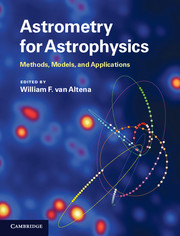Book contents
- Frontmatter
- Contents
- List of contributors
- List of acronyms
- Preface
- Part I Astrometry in the twenty-first century
- Part II Foundations of astrometry and celestial mechanics
- Part III Observing through the atmosphere
- Part IV From detected photons to the celestial sphere
- Part V Applications of astrometry to topics in astrophysics
- 22 Galactic structure astrometry
- 23 Binary and multiple stars
- 24 Binaries: HST, Hipparcos, and Gaia
- 25 Star clusters
- 26 Solar System astrometry
- 27 Extrasolar planets
- 28 Astrometricmeasurement and cosmology
- Index
- References
27 - Extrasolar planets
from Part V - Applications of astrometry to topics in astrophysics
Published online by Cambridge University Press: 05 December 2012
- Frontmatter
- Contents
- List of contributors
- List of acronyms
- Preface
- Part I Astrometry in the twenty-first century
- Part II Foundations of astrometry and celestial mechanics
- Part III Observing through the atmosphere
- Part IV From detected photons to the celestial sphere
- Part V Applications of astrometry to topics in astrophysics
- 22 Galactic structure astrometry
- 23 Binary and multiple stars
- 24 Binaries: HST, Hipparcos, and Gaia
- 25 Star clusters
- 26 Solar System astrometry
- 27 Extrasolar planets
- 28 Astrometricmeasurement and cosmology
- Index
- References
Summary
Introduction
The Doppler detection of the Jupiter-mass planet around the nearby, solar-type star 51 Pegasi (Mayor and Queloz 1995) heralded the new era of discoveries of extrasolar planets orbiting normal stars. Four different techniques have been successfully used for the purpose of exoplanet detection. Decade-long, high-precision (1–5 m/s) radial-velocity surveys of ˜3000 F-G-K-M dwarfs and subgiants (e.g. Butler et al. 2006, Udry and Santos 2007, Eggenberger and Udry 2010) in the solar neighborhood (d ≤ 50 pc) have yielded so far the vast majority of the objects in the present sample (a total of over 760 planets in ˜600 systems, as of June 2012). Ground-based photometric transit surveys (e.g. Char-bonneau et al. 2007, Collier Cameron 2011) are uncovering new transiting systems at a rate of ˜30 per year, while space-borne observatories such as CoRoT and particularly Kepler hold promise of increasing by an order of magnitude the present yield (over 230 transiting systems known to date). Finally, over three dozen sub-stellar companions have also been detected so far by means of gravitational microlensing (e.g. Bond et al. 2004, Beaulieu et al. 2006, Gaudi et al. 2008, Muraki et al. 2011), direct-imaging surveys (e.g. Chauvin et al. 2005, Kalas et al. 2008, Marois et al. 2008, 2010), and timing techniques (Silvotti et al. 2007, Lee et al. 2009, Beuermann et al. 2010).
- Type
- Chapter
- Information
- Astrometry for AstrophysicsMethods, Models, and Applications, pp. 379 - 394Publisher: Cambridge University PressPrint publication year: 2012



